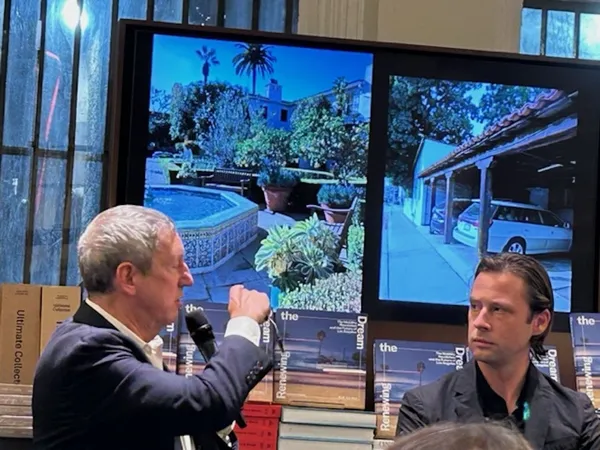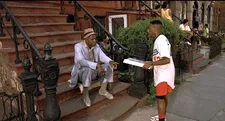 |
| James Sanders with Matt Ducharme (of Woods Bagot) at the Rizzoli book launch in New York of Renewing The Dream: The Mobility Revolution And The Future Of Los Angeles Photo: Anne Katrin Titze |
In the second instalment with architect, author, filmmaker James Sanders (co-writer with Ric Burns on the PBS series New York: A Documentary Film), we discuss the Billy Wilder connection to producer Jeremy Thomas and Jonathan Coe’s Mr. Wilder And Me; Wilder’s The Seven Year Itch (based on George Axelrod’s play, starring Tom Ewell and Marilyn Monroe) and The Apartment (co-written with I.A.L. Diamond and starring Jack Lemmon); Woody Allen’s Manhattan, Mariel Hemingway, and apartment sounds; Spike Lee’s Do the Right Thing and the stoop; the office building and Jean Negulesco’s The Best of Everything; Daniel Mann’s Butterfield 8 (with Elizabeth Taylor, Lawrence Harvey, and Dina Merrill) and and the canopy; Blake Edwards’s Breakfast At Tiffany’s (based on Truman Capote’s book, adapted by George Axelrod and starring Audrey Hepburn with George Peppard), and how certain stories can only happen in certain locations that are built to bring us together or keep us apart.
 |
| James Sanders on Billy Wilder: “For so many of his New York films, Sabrina being another example, he was so insightful about the way New York worked.” Photo: Anne Katrin Titze |
Renewing The Dream: The Mobility Revolution And The Future Of Los Angeles (Rizzoli, 2023) is edited by James Sanders and produced with the global architecture studio Woods Bagot. The book includes artwork of David Hockney, Catherine Opie, Ed Ruscha, Wayne Thiebaud, Carlos Almaraz, and stills from Damien Chazelle’s La La Land to Roman Polanski’s Chinatown. The preface is by Nik Karalis with contributions from Frances Anderton, Donald Shoup, Mark Valliantos, and Sanders himself, who writes about “one of the most magical and beloved residential models ever to arise in Southern California: the bungalow court and courtyard apartment projects of the 1920s and ’30s,” which inspired movies and novels and may be the solution for a 21st century Eden reclaimed.
From New York City, James Sanders joined me on Zoom for an in-depth conversation on Celluloid Skyline: New York And The Movies and many of the filmic locations in the book.
Anne-Katrin Titze: I always dislike when people write or say that a building is a character. The building is not a character, the building is a building. But the story is dependent on the buildings!
James Sanders: Exactly. Not like a character at all. I hate that construction - the city is almost like a character. The one thing it isn’t is a character, in my view. In the case of Rosemary’s Baby, it’s taking the story of hearing strange sounds from the next apartment, which by the way is something that every New Yorker has experienced one way or another.
 |
| Jack Lemmon in Billy Wilder’s The Apartment |
You remember somewhere in the middle of either Manhattan or Annie Hall, it has to be Manhattan, where Woody Allen has quit his job. In the film he’s supposed to be writing for what is evidently Saturday Night Live, but he decides he’s not going to do that anymore because he has too much integrity. But now he doesn’t have any money and he can’t live in that beautiful townhouse anymore.
So he’s moved to a new and quite smaller apartment and he’s spending his first night or two in the apartment and he says to Mariel Hemingway: “What is that sound? It sounds like they’re strangling a trombone!” That’s just an ordinary, un-demonic version of the story. Taking that common experience and then pushing it to the limit. What if it was a diabolical cabal? Living and working and doing their cabalistic things in the next-door apartment. And they were coming for you.
AKT: Always possible in New York! Or it could be the Seven Year Itch, where the house is part of the plot. As you say, not possible in another kind of building. A sentence I very much like is about Billy Wilder’s The Apartment. “Even in this classic portrait of urban loneliness, the domesticity of the building reasserts itself.” Very true, these are the contradictions of living here.
 |
| Marilyn Monroe and Tom Ewell in Billy Wilder’s The Seven Year Itch |
JS: Perfect example of this sort of way the filmmaker, in this case Billy Wilder, Seven Year Itch is a little more complicated, where the filmmakers anatomise these New York forms. In the case this one particular form, which has no name curiously, in which what was once a townhouse, a single-family home in the city was subsequently cut into little, sometimes called maisonettes. But that’s not really what they are.
They’re basically little apartments, single-floor, sometimes two to a floor apartments in the front and back of the five stories of an old single-family house. Because the apartments were cheap, it became a very desired place for young people to live, like the character of C.C. Baxter, the Jack Lemmon character in The Apartment.
Or it could be a full-floor apartment comfortable for a family, like the one in Seven Year Itch. In the case of Seven Year Itch this neighbor arrives, she never, by the way, in the script has a name, she is just “The Girl,” Marilyn Monroe, of course. And I argue that the entire story could not have taken place in any other kind of building, because apartment buildings are designed to keep their tenants apart.
AKT: Hence the name.
JS: You don’t run into your neighbors in an apartment house. You don’t have repeated interactions with them, certainly not in the short time of a few weeks in the summer. And the building isn’t trying to put you together, in an apartment house it’s trying to keep you apart. But in this old townhouse, which once was a family, as Tom Ewell says to Marilyn Monroe, “We’re all one big family here,” the building is trying to put them together.
AKT: His wishful thinking.
JS: In The Apartment, the neighbor, the doctor, who kind of saves the girl. And then of course the best example would be Breakfast at Tiffany’s.
AKT: The fire escapes connecting.
JS: Yes, all these single people. Audrey Hepburn and George Peppard don’t quite realise how the building is putting them together.
AKT: Apropos Billy Wilder, yesterday I went to a reception for Jeremy Thomas, the producer, who worked with Cronenberg, Nicolas Roeg, Bertolucci, etc. We talked about his upcoming project, Mr. Wilder & Me, based on the novel by Jonathan Coe, that he is trying to finance.
JS: Wilder had himself a kind of cinematic life and was himself so witty and intelligent. For so many of his New York films, Sabrina being another example, he was so insightful about the way New York worked. As far as I know he never lived in New York. As you know, he’s from Berlin and got out.
 |
| Mariel Hemingway with Woody Allen at an art gallery in Manhattan |
AKT: Originally Austria, near Vienna, then Berlin.
JS: Vienna. Everybody had to come through New York, of course in those days, by ship.
AKT: But he never stuck.
JS: I don’t think he ever spent much time here. I do know stories about him living in the Chateau Marmont in what was basically the bathroom. I don’t think he ever lived here. They all often came to New York because of premieres or meetings. This is another part of the story, that although the production of Hollywood movies was in Los Angeles, every other aspect of the Hollywood studio system was in New York.
The administrative offices were almost entirely here, except for Disney. The funding came from Wall Street bankers, the publicity and distribution departments were all based in New York. As we say, Clark Gable may have acted in front of the cameras in Culver City but his paycheck was signed at 1580 Broadway at the Loew’s Building on Times Square.
AKT: Wilder captures so much about the city, simply with the elevators and the elevator girl in The Apartment. The Best of Everything, it’s not Wilder, but I think it is one of those films that is great showing office building and work dynamics. But I do want to talk to you about the canopy! I never thought about this before reading your book [Celluloid Skyline: New York and the Movies]. Butterfield 8 is a great example of its use as the intersection of the home and the street. Whom does it belong to?
 |
| Elizabeth Taylor with Dina Merrill under the canopy in Daniel Mann’s Butterfield 8 |
JS: That was another thing, now you’re getting to what I think is the really beating heart or the core core idea of the book, which is that all these things I wanted to say about how subtle and rich New York was, the organic New York that built up from the 1850s or 1840s, to roughly 1945 and then was basically ignored for the next 40 years by modernists. There was such complexities and subtleties of meaning to these elements and one of them was that the apartment house was, with lots and lots of apartments in it, unlike either the townhouse that had come before or the tenement - it didn’t have a stoop.
It didn’t have a stair that could be this kind of entrance gesture, so that the people coming to the building knew that they were sort of slightly leaving the hurly burly of the city behind and being embraced by the building, even while they were still in the city. Then of course in the case of the stoop you have this other kind of wonderful use, as sort of bleachers to the activity of the street, beautifully shown in films like Do The Right Thing.
As a kind of substitute they created the canopy which had a functional purpose of keeping people out of the rain as they came from their taxi or car to the apartment house entrance so they wouldn’t get wet for middle class people. It made perfect sense but it did so much more than that. It sort of claimed a piece of the public realm of the city, the street.
 |
| Ossie Davis on the stoop with Spike Lee in Do the Right Thing |
The sidewalk really, as the domestic domain of the apartment house. So that’s going in one axis, from the front door to the building. But then the other axis, the street axis that goes parallel to the front passes right through. There you have the domestic realm and the larger city realm. And how better to show it than having Elizabeth Taylor bringing a fur coat.
AKT: That belongs to Dina Merrill!
JS: The mistress of a man who lives in the building, Lawrence Harvey, seeing his wife, the real domain user of this thing. Where else would that be able to happen? In other words, they are bringing to life the dual reality of this one piece, this urban fixture in this mesmerising way. What I discovered was again and again and again, directors, production designers, art directors were quietly insightful about the city.
They never wrote anything about this, they don’t write essays by and large and when they do, they tend to be more essays about anecdotes that happened during shooting. Or maybe occasionally like Hitchcock talking a little bit about lenses he used and so forth. But they didn’t tend to write about how they used built sets. So I have appointed myself the middleman between the filmmakers and the general public.
 |
| Renewing The Dream: The Mobility Revolution And The Future Of Los Angeles, edited by James Sanders Photo: Anne Katrin Titze |
Read what James Sanders had to say on Joan Didion’s wisdom, Cedric Gibbons’s dream sets in the sky, George Stevens’s Swing Time (starring Fred Astaire and Ginger Rogers) and Robert Z Leonard’s Susan Lenox (with Greta Garbo and Clark Gable), East River running with Jill Clayburgh and Michael Murphy in Paul Mazursky’s An Unmarried Woman, the mansion in George Cukor’s Holiday giving Katharine Hepburn and Cary Grant the chance to represent the departure of the 19th century, Howard Hawks’s Ball Of Fire (co-written by Billy Wilder and Charles Brackett, starring Barbara Stanwyck and Gary Cooper), The Dakota, the Alwyn Court and Roman Polanski scouting with Richard Sylbert for Rosemary’s Baby, New York, a documentary film series with Ric Burns and our shared admiration for and friendship with the great independent documentarian Nancy Buirski.






















